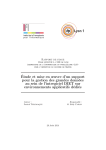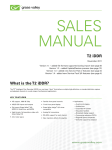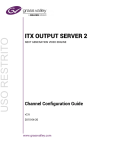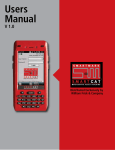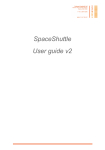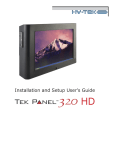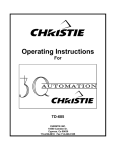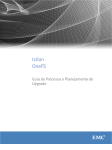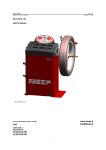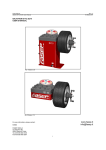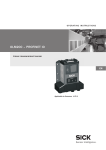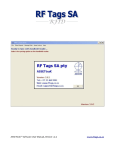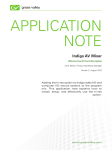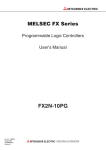Download Using GV STRATUS Import Rules to Effectively Manage External
Transcript
Using GV STRATUS Import Rules to Effectively Manage External Content Ingest Bea Alonso, Director, GV STRATUS Business Development August 2014 APPLICATION NOTE USING GV STRATUS IMPORT RULES TO EFFECTIVELY MANAGE EXTERNAL CONTENT INGEST W ith the proliferation of digital media, content producers have to deal with a growing variety of media formats ingested from diverse sources, and delivered over global distances via a mix of high-speed media transport technologies and often involving cloud-based storage models. The challenge then is to quickly and transparently ingest content across a diversity of environments, and make it available in collaborative workflows. This application note examines the use cases involving media import, and how the GV STRATUS workflow engine can be applied to create automated import rules that speed up and automate routine production processes. Introduction Today, content producers need to deal with a variety of media formats coming from different sources, which need to be quickly and efficiently processed and managed through the production workflow. Adding to this mix, production houses can receive raw digital content from their clients over global distances, involving an increasingly complex combination of cloud-based storage, traditional TCP-based data transfer methods such as FTP, as well as emerging high-speed media transport technologies. Meanwhile, news broadcasters receive content from very different source types, and divergent assortment of formats and resolutions. Citizen journalists are capturing newsworthy events with their mobile devices, and sharing them via email or through social media platforms. Producers and reporters demand the ability to quickly make this content available within their production systems, where it can be edited and rapidly turned around for on-air broadcast. www.grassvalley.com This environment demands a media production platform that abstracts the complexities of ingesting material from disparate sources, while enabling the creative teams to focus on what they do best — producing more compelling content. Addressing this business need, the GV STRATUS production platform from Grass Valley, a Belden Brand, offers flexible, user-friendly and easy-to-configure workflow rules to automatically import content from external locations into the GV STRATUS/K2 system, including associated metadata. The primary benefit to the media organization is that content is made available for users to work collaboratively as soon as it starts arriving. Growing files are fully supported, meaning that any GV STRATUS user can browse, edit, sub clip and prepare for delivery within seconds of the start of the file import process. 2 APPLICATION NOTE USING GV STRATUS IMPORT RULES TO EFFECTIVELY MANAGE EXTERNAL CONTENT INGEST User Applications GV STRATUS Import rules provide broad abilities for importing virtually all media formats, including user-generated content (UGC), still images and audio files. Once imported into the K2/GV STRATUS environment, all assets are internally represented in K2 Common Movie Format (CMF), providing a common asset model for proxy, edit constructs, transitions, playlists and metadata. The new GV STRATUS Import rule addresses a wide range of use cases, with some of the most prominent examples detailed below. Mobile News A field reporter has just recorded a late-breaking event with his mobile equipment and would like to make the content available to the producer, video editor and news director at the central news facility. Through a WAN-based connection, he uploads his video contribution to a cloud-based storage, which is being watched by a GV STRATUS Import rule. Since the video was recorded as a QuickTime file www.grassvalley.com with a codec that is K2 compatible, GV STRATUS can import it natively. As soon as the import process begins, the video clip appears as a growing file on the GV STRATUS system, in a bin designated for field-contributed content. Immediately, the production team can collaboratively access and process the contributed content. Working from their desktops in low-resolution mode, producers and directors can browse the content and clip up extracts ready for on-air broadcast or web publishing. Likewise, video editors can start editing the content in their nonlinear editing application (e.g., EDIUS Elite, Adobe Premiere Pro CC, etc.). The final edit can be sent to playout within seconds of the media being uploaded from the field. 3 APPLICATION NOTE USING GV STRATUS IMPORT RULES TO EFFECTIVELY MANAGE EXTERNAL CONTENT INGEST Owing to the unmatched versatility of the GV STARTUS workflows, field reporters also have the option to take a broader role in the story creation. Running a GV STRATUS client application on their Internet-connected device, reporters can connect to their central newsroom system and access the contributed media on the K2/GV STRATUS system while the content is getting imported. They can clip up the material, edit it and prepare for playout. This enables them to take a broader responsibility for the story, from shooting to sending the final edit for news broadcast or web publishing, without intervention from the central newsroom. Alternately, if the final story is to be reviewed/approved by a director or producer, the import process can place the file on “Review and Approval” bin and send an email notification to the supervisor. Upon approval, the file can be automatically moved to a playout location. File Delivery of News Agency Feeds File Delivery for Production File Exchange between Radio and TV Content can often arrive in a production or news facility via FTP file delivery, or via another high-speed file delivery method such as Aspera’s FASP. Files can also be transported by email or shared over corporate networks. GV STRATUS can be instructed to watch any of these external file locations via an import rule which can then create the media (with or without metadata) within the K2/GV STRATUS production system. As described in more detailed in the “How GV STRATUS Import Rules Work” section, import rules define how an imported file is treated, based on the relevant file attributes. Often times, radio and TV departments work side-by-side and may want to exchange media files. Yet bridging these two production environments requires a unique file sharing arrangement. While the TV production department works with complete video assets, the radio team only requires the audio portion of the same video content. For instance, a rule can instruct the system to automatically transcode to HD any file containing “SD” in its title, prior to importing it into the K2/GV STRATUS system. Or, as another example, a rule can be created to ignore all files with the file extension “ini.” Downloadable Public Content A video file or still image that is publicly available on the Internet may be essential to a specific production or news story. However, such content may be posted in many different resolutions and formats. GV STRATUS Import rules help automate the process of importing these files in the correct house format (via a transcode engine) and place them on a location accessible to all those who need the content. www.grassvalley.com News agencies deliver all of their news feeds to subscribed clients as a file with metadata. GV STRATUS Import rules provide a transparent solution to make these files available to all newsroom and remote users. Import rules can be set up to import content to different GV STRATUS bins according to media title (e.g., Sports, Finance, International, etc.), duration, date and other parameters. Auto-delete rules can also take care of regularly deleting imported feeds, based on “time elapsed since delivery” or “time elapsed since last use.” Field/remote users can connect to the GV STRATUS home system via the Internet, and search, browse and edit agency feeds in low-resolution mode, as well as send their final edits to the playout/delivery server. GV STRATUS Import and Export rules will facilitate such file exchange. Radio production teams can, for example, place audio-only files on a shared location watched by a GV STRATUS Import rule. As instructed by this rule, audio files will be imported into the GV STRATUS system as K2 assets, including metadata such as markers. Similarly, using a metadata field, checkbox or action bin, a TV production team member can establish an export rule that transcodes designated video files as audio-only assets (with associated metadata). The rule instructs the system to place these assets on a shared network location where they can be accessed by the radio production system. File Delivery for Transmission Environments GV STRATUS is also used as the preparation tool and asset manager for transmission and playout automation environments. In this application, ready-for-air content such as commercials, promos, movies and programs may be delivered with a full set of metadata via file transfer. GV STRATUS Import rules can selectively fetch content as it arrives and import it, alongside the metadata information, to specific media type bins (e.g., “Movies” bin, “Commercials” bin, etc.) within the asset management system. 4 APPLICATION NOTE USING GV STRATUS IMPORT RULES TO EFFECTIVELY MANAGE EXTERNAL CONTENT INGEST How GV STRATUS Import Rules Work From the GV STRATUS Control Panel, Import rules can be created for varying workflow requirements by specifying parameters such as import folder location, file name, file extension and so on. Accompanying metadata is mapped to the GV STRATUS database from an XML file and imported together with the video content. System level view of GV STRATUS Import workflow is shown below: Dashed line indicates optional step Rule is executed 3 and starts a workflow 2 GV STRATUS The trigger matches a criterion of an Export Rule Workflow and Rules Engine 6a Custom metadata, if provided, is written to GV STRATUS database Database 4 1 A metadata change takes place on watched folder If rule configured to transcode, Xcode Control Engine issues transcode order to 3rd party transcoder 5 External Server / Network Location www.grassvalley.com Transcoder gets file from import location 7 GV STRATUS Clients Xcode Control Engine 6 3rd party Transcoder CIFS K2 Working Directory LxO RAID STORAGE File essence is imported to K2 FTP K2 SUMMIT 3G PRODUCTION SERVER K2 SAN/Summit 5 APPLICATION NOTE USING GV STRATUS IMPORT RULES TO EFFECTIVELY MANAGE EXTERNAL CONTENT INGEST File Formats and Automatic Transcoding There are many industry-standard formats that can be natively imported into the K2/GV STRATUS framework. If external media needs to be transcoded prior to import into the K2/GV STRATUS system, a transcode process is simply added to the workflow rule. The automated execution of the transcode operation can be monitored through the GV STRATUS monitors, but is otherwise transparent to the user. Users working in collaborative workflows typically prefer to have all files converted to their in-house mezzanine format, so that there are no requirements to transcode after editing and before final delivery (either via on-air broadcast, an external file transfer or digital media publishing). GV STRATUS interworks with mainstream transcode solutions, including Harmonics ProMedia Carbon, Elemental Technologies and Telestream Vantage. For further information about natively-supported file types, specifications and formats, please consult the GV STRATUS Online Topic Library and the K2 System datasheet. Import Rules Configuration Rules are created, edited, enabled and/or disabled through the Rules Editor in GV STRATUS Control panel. Multiple rules can be applied across a GV STRATUS workflow, with parameters responding to a variety of production requirements. • Transcode format. This parameter indicates whether the file is to be imported in its native format or transcoded before import. • Optional/required indicator for metadata delivery on import. As an example, transmission environments typically require that all playout-ready imported files must come with a set of metadata information, such as House ID, or copyright details. • Source location, including subfolders, if desired. This parameter specifies the external destination (e.g., shared network drive, FTP location) where GV STRATUS will watch for arriving new files. Note that it is important to also enter the user credentials, including the domain name (or machine name) so that the GV STRATUS workflow engine can access the external import location. Composed of a broad range of parameters, GV STRATUS Import rules facilitate a very granular level of media production orchestration. • Priority of this rule over other workflow automation rules. For example, importing user-generated content may be of higher priority than sending content to archive. • Destination folder within K2/GV STRATUS. Users can specify the K2 bin where the file and associated metadata is to be imported within the production system. • Rename or overwrite. If a file arrives with the same name as a previously imported one, users have the option to overwrite (delete the previously imported file) or import it with an extension, such as “AssetName_imp01.” • Email notifications. Users can set up an email address that will be notified if the file import completes successfully, or fails, or both. For instance, a producer may choose to be notified every time a new promo is delivered by a freelance editor and imported to the system. www.grassvalley.com • Frequency. This parameter determines when the rule is triggered — whether by a metadata change (in other words, as soon as a file arrives or is changed), or periodically according to a specific time or frequency. 6 APPLICATION NOTE USING GV STRATUS IMPORT RULES TO EFFECTIVELY MANAGE EXTERNAL CONTENT INGEST • Rule conditions. These conditions allow users to add granularity to the rule’s behavior. The four user-defined parameters can be combined so that any or all of the conditions have to be met in order to trigger the rule. –– File Name: Sets a condition based on the file’s title (is/is not/ begins/ends/contains). For example, if “contains sports” is applied, the rule will be triggered on all arriving files with the word “sports” in their title. Through its Destination parameter, this rule may also require that these files be imported into a logical destination, such as a bin containing sports material only. –– File Extension: Specifies explicit file types (e.g., jpg) that are to be imported to a bin. Alternately, users may need to identify certain file types to be ignored by the import rule. The file extension can be typed in the rule parameter without the “.” prefix. –– File Size: Invokes the rule only on files with the specified size, for example “not larger than 300 GB.” –– File Modified Date: Allows users to identify a conditional range of dates or a time period. This enables users to create rules such as “don’t import files older than,” “import files newer than” or “import content only a day after arrival” and so on. File Transfer Progress Monitoring Users can monitor the progress of import jobs from the GV STRATUS Monitor tool. The status of each rule-automated import process is reported from start, through the transcoding phase, to successful completion/import of the file to the destination location. As well, the system also indicates an import job failure, including error message information. Successfully imported files are renamed by the system to “Filename_Imported_successfully.” Files that fail to import (after GV STRATUS attempts to import three times) will receive a post-fixed name “Filename_Import_failed.” These renamed files are kept in the system for seven days, allowing the system administrators to periodically review the history of import jobs on folder bases, and quickly check for issues. After seven days, the GV STRATUS system will automatically delete them, with no additional housekeeping required. www.grassvalley.com 7 APPLICATION NOTE USING GV STRATUS IMPORT RULES TO EFFECTIVELY MANAGE EXTERNAL CONTENT INGEST Summary To succeed in today’s rapidly-paced production environment, media companies need a complete framework for efficient import of files arriving from a variety of sources and in a mixture of formats and resolutions, while making them available in collaborative workflows. Featuring a robust workflow and rules engine, GV STRATUS makes the process of importing media content transparent to the users. With minimum training required, GV STRATUS users can create and pro- vision automated import rules that speed up and automate routine processes while abstracting complex technology from the creative process. This benefits the media creators, content producers and delivery providers alike — with GV STRATUS, they can deliver more innovative content, gain a fast-turn-around edge over their competition, and open new media distribution channels. References For more information about K2/GV STRATUS import workflows, consult Grass Valley online resources at www.grassvalley.com: • Grass Valley K2 Media Platform System Guide • K2 System Datasheet • GV STRATUS User Manual • GV STRATUS Topic Library • K2 Media Platform: Media Formats and Interchange — application note • Import and Export of Files in K2 Media Platform — application note For more information about Harmonic ProMedia Carbon engine, consult Harmonic online resources at www.harmonicinc.com: • ProMedia Carbon — product page • ProMedia Carbon — datasheet • ProMedia Carbon — format guide • ProMedia Carbon — support For more information about Telestream Vantage family of solutions, consult Telestream online resources at www.telestream.net: • Telestream Vantage — product page • Telestream Vantage — product brochure For more information about Elemental Technologies encoding solutions, consult Elemental Technologies online resources at www.elementaltechnologies.com: • Software-defined video processing — product pages For more information about Aspera high-speed media transfer solutions, consult Aspera online resources at www.asperasoft.com. GVB-1-0006A-EN-AN WWW.GRASSVALLEY.COM Join the Conversation at GrassValleyLive on Facebook, Twitter, YouTube and Grass Valley - A Belden Brand on LinkedIn. Belden, Belden Sending All The Right Signals and the Belden logo are trademarks or registered trademarks of Belden Inc. or its affiliated companies in the United States and other jurisdictions. Grass Valley, K2 and GV STRATUS are trademarks or registered trademarks of Grass Valley. Belden Inc., Grass Valley and other parties may also have trademark rights in other terms used herein. Copyright © 2014 Grass Valley. All rights reserved. Specifications subject to change without notice. 8









